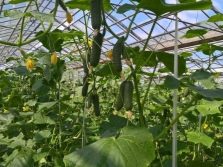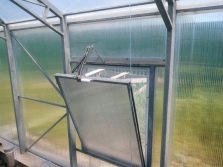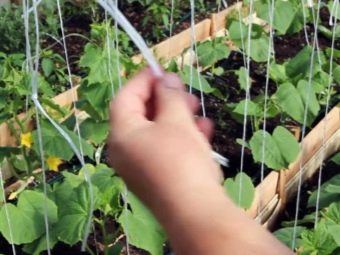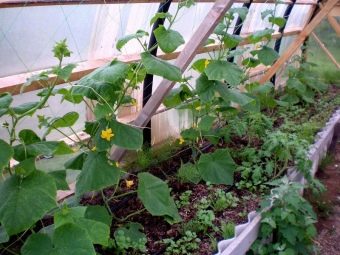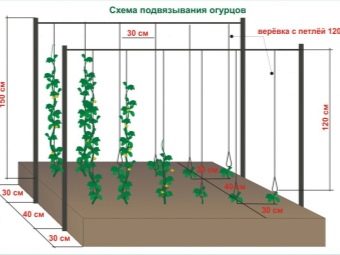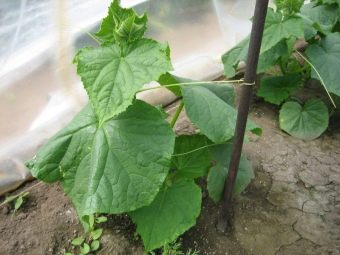How to tie cucumbers in a greenhouse?
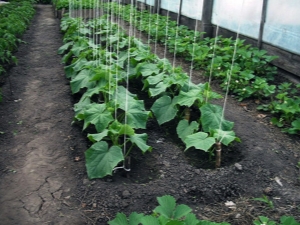
Cucumber - a vegetable crop that requires constant care.To get a rich cucumber harvest, you must follow the rules of cultivation, to perform various activities for the care of plants. One of them - tying shoots. Many gardeners ask questions, is it worth it to tie up the culture, how to properly tie cucumbers in the greenhouse and why is it necessary?
Features of the procedure
Experienced gardeners recommend be sure to tie cucumbers, which are grown in a greenhouse made from ordinary film, or in a greenhouse made of polycarbonate. Indeed, in these conditions, methods of care for vegetables are significantly different from growing vegetables in the open field. In the greenhouse, the level of humidity and air temperature is higher than in open space, and these are ideal conditions for the vital activity of harmful organisms, which leads to rotting of leaves and fruits and the spread of fungal diseases on plants. Unbound vegetable culture at such a humidity and temperature ceases, and then simply dies.
In a greenhouse, it is very important that measures to ventilate the room are constantly carried out. The stagnation of moisture detrimental effect on the development of vegetable crops, and also significantly reduces the yield of cucumbers. The garter provides free circulation of air between the bushes. Tie up the vegetable culture should be when the plant reaches 30 centimeters and 3-5 true leaves will be formed on it.
If tying up is carried out at a later date, then you should act with great care, because the plants are quite soft and brittle, and with a large length of them, any careless movement can damage the seedlings.
According to reviews of vegetable growers, tying cucumber seedlings provides some other advantages for growing.
- With proper tying, you will significantly save a useful place in the greenhouse, because in such rooms there is a problem with free space. At the same time, areas are freed up, where in the future it will be possible to plant other vegetable crops (greens, cabbage).
- Cucumber seedlings will grow in 1-2 months and there will be little space for it, and the attached plants will weave their whips on a special support, thus they will not braid neighboring vegetables and shade each other.
- Tied up seedlings will be illuminated evenly, and this contributes to a better formation of ovaries on the plant, and hence an increase in yield.
- This method of growing cucumbers greatly simplifies the care of plants. When the seedlings are treated with special means from diseases and harmful microorganisms, each leaflet will be treated evenly, and this cultivation option makes it easier to harvest the fruit.
- Tied bushes do not darken each other, as when growing seedlings in the holes, the cucumber harvest will be of higher quality, because the contact of fruits with the soil adversely affects the formation of cucumbers (they turn yellow and twist). Tied cucumbers will not be attacked by various harmful insects, as well as diseases that can arise from constant contact with the ground and thickening of the landings.
It is especially important to carry out activities for tying in greenhouses made of polycarbonate. After all, this building material is an obstacle to the normal circulation of air, which leads to the death of many vegetable crops.
Garter Techniques
There are many methods of garter cucumbers, each of which differs by the type of devices used. For this purpose, tapes made of durable material, metal or wooden supports and a strong rope, to which the plant stems will be tied, will be used. The necessary devices can be made independently, while the width of the tape should be from 3 to 5 cm, and the length - at least 25 centimeters.
When choosing a particular method, you should take into account the features of the beds and the parameters of the greenhouse itself.Please note that different types of tying are suitable for different types of cucumbers. If one variant of garter is suitable for bush plants, then for other varieties of cucumbers you need to choose a different method.
Horizontally
The horizontal version of the garter cucumber seedlings is the most popular among gardeners. For this purpose, pegs made of wood or metal, whose height should reach 2 meters, are instilled at the edges and throughout the whole bed. Between all supports stretched rope or twine in 1-2 rows, the distance between the ropes should be at least 25 centimeters. Each cucumber bush is tied to a rope, and hence the number of ropes depends entirely on the number of plants.
Tying up cucumber seedlings by the horizontal method has its drawbacks:
- in the future, cucumber bushes will intertwine with each other, and this negatively affects the future harvest;
- when the stalk reaches the topmost rope, the sticks will begin to hang down, which will darken the lower plants.
If the height and dimensions of the greenhouse allow it, it is better to install pegs of greater height (more than 2 meters). Experienced vegetable growers, using a horizontal garter of cucumber bushes, when the stem reaches the upper rope, cut the elongated processes, thereby stopping their further growth.
Upright
In the vertical way of tying up seedlings, a special support will be required, the size of which, just as in the first variant, should reach 2 meters. In this way it is convenient to tie cucumbers in high rooms. The frame is installed in such a way that the upper part is located under the ceiling covering, and the lower one is laid on the ground. Between them, wire or rope is stretched, the number of which depends entirely on the number of cucumber bushes. As a result, each bush will wrap around one wire, but at the same time it will be necessary to tie side shoots, because they will hang down and darken the lower plants.
To simplify the work, many gardeners do not use the support structure, and the rope or twine is tied to the ceiling base of the greenhouse on which hooks are pre-installed. At the same time, metal pegs are driven into or poured into the ground, after which it will be necessary to tie a rope.
If wooden parts are used, they should be pre-treated with a solution of salt, which is mixed with a special means against rotting. In the future, the gardener will need to additionally tie up the stalk, weaving along the rope, because the ripe fruit will pull it down.
There is another way to vertical garters, it differs from the previous version of the design, which is used as a support. For this purpose, use a metal support U-shaped. This product has a high rate of stability, and also allows the plant to grow along the top bar. The height of the support can reach 2 meters.
To fix the massive structure, it is necessary to additionally install lateral thrust materials. Between the straps, rope, wire or twine are stretched, the distance between which must be at least 30 centimeters. As the cucumber seedlings grow, it is necessary to constantly twist the antennae of the stem around the twine, as well as adjust the rope. The design with this method of tying cucumbers differs by a long service life, because it is enough to establish a support once, which will last several years.
As required, you will need to change only the twine.
Experienced growers often use the combined (mixed) method of tying. It is used if the cucumber seedlings are planted in a circular pattern of planting. Tying is carried out in two stages.
- First of all, 8-10 pegs made from metallic materials are buried in the soil. They are set so that a cone is formed as a result.
- On this design tensioned mesh. In the available special holes run mustache cucumber seedlings. This is the end of the tying technology, and as the plant grows, it will itself follow the construction, as a result we will get a small green hut.
If you decide to use the combined method of tying cucumbers, the design of a cone-shaped shape must be installed before planting cucumber seedlings. When installed after planting there is a risk of damage to the root system and the leaf plates of the plant.
Materials
As already mentioned, the methods of cucumber garters depend on the materials used. Consider the most popular materials that are used for tying cucumber stalks.
Rags
Often, growers use textiles to tie cucumber seedlings. This material is the most economical, because almost all of them will find old, unnecessary things, from which flaps of certain sizes are cut. The length of one flap should be at least 25 cm, and the width of at least 5 centimeters. To obtain the desired size, pieces of patches are sewn or bound together.
Textiles are the safest for seedlings, because even with a strong tightening they are unlikely to damage the plant. But this material is not very durable, so when it is used it is worth thinking about an additional way of tying cucumber stalks.
Twine
This material is the most convenient to use, and it is not subject to the formation of mold and rot. For growing vegetables it is recommended to purchase jute splits, synthetics in this case will not work. Synthetic material when ripening fruits and weighting lashes will stretch and cut the cucumber stems. The upper part of the twine is mounted to the profile of the greenhouses, and the lower one goes down, where further fastening is carried out to the peg, and a loop is made under 2 or 3 of this sheet (at least 30 cm from the ground). The plant should be twisted around the twine above each leaf plate.
If you grow bush cucumbers, you can attach additional twine, which will be tied side stalks, and the distance between them should be at least 40 centimeters. As soon as the side shoots can be held independently on the supporting structure, the twine can be removed.
Branches
You can also use thin straight branches to support cucumber plants. They are pre-prepared by removing the bark, leaving one twig. This material is instilled into the ground, and the upper part is fixed with wire. It is possible to mount branches both to the trellis and to the greenhouse frame. The last option of fixing is suitable for low rooms or for those cases when cucumber seedlings are planted along the walls.
The advantage of this material is the better fixation of the stems, but at high humidity in the greenhouse, the branches will not last for a long time without prior treatment.
Step-by-step instruction
Caring for greenhouse plants is not limited to activities for tying seedlings, the next moment will be the formation of cucumber bushes. Novice gardeners often ask whether it is worthwhile to puttling cucumber seedlings and how this is done.
Many growers believe that fruits can be gathered on the side branches, but experts say that the central stem is the main fruit bearing branch. The side stepsons will only take nutrients for their development, and the main stem will lose their yield. The side branches will not give the crop, which can be collected from the central whip.
How to pinch cucumbers that are grown in a greenhouse? When carrying out this procedure, you should act with extreme caution, because there is a risk of damage to the plant. Experts recommend pinching shoots with small scissors.Consider an example where the tying of cucumber seedlings is done in a vertical way using twine. It is necessary to act in this case step by step in order not to make any mistakes, because otherwise you can destroy the plant and remain without a crop.
- At the bottom of the stem, where there are 3-4 true leafy plates, you should get rid of ovaries and shoots. This procedure is necessary to further develop the root system of the plant normally, and this in turn is important for the whole plant, because the main food comes from the soil through the root.
- In the area of the next three leaves should get rid of the side shoots, and the ovary is not touched. Removal of shoots should be carried out in the earliest terms, because otherwise you can provoke various diseases in the plant. Experts also recommend removing leaf plates before the first fruit, and leave those leaves where there are ovaries.
- In the next three leaves should leave the ovary with cucumbers, as well as give the opportunity to grow lateral shoots. When one leaf and one ovary are formed on the shoot, it is necessary to pinch the shoot. Places of pinching should be treated with a solution of potassium permanganate, so that in the future the plant is not at risk of disease.
- The shoots of the next 3 leaves should be formed in a similar way, only in this case 2 leaves and 2 ovaries should be left. The higher the leaves, the greater the number of ovaries to leave.
- When the first lower fruits appear on the stem, they must be harvested as quickly as possible. In this case, the lower leaf plates should be removed.
- As soon as the central lash reaches the top level of the string, it must be untied, and the plant should be lowered down. So you make room for the growth of seedlings up.
The technology of tying up and forming cucumbers is rather laborious, but this process carries a lot of positive factors for growing fruits. The main thing is to follow all the rules and advice of experienced farmers, then it will be quite possible to achieve a rich cucumber harvest.
To learn how to tie cucumbers in the greenhouse, see the video below.



